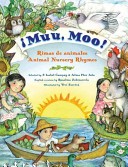
This bilingual collection of traditional animal nursery rhymes from Spain, Latin America, and the United States is sure to delight readers young and old. Includes 17 poems handpicked by Ada and Campoy, along with five of their own original poems.
- ISBN: 9780061346132
- Authors: Ada, Alma Flor; Isabel Campoy, F.
- Illustrator: Escriva, Vivi
- Published: 2010 , HarperCollins
- Themes: Animals, nursery rhymes
- Descriptors: Bilingual, Caribbean, Cuba, Early Years (ages 2-6), Latin America, Picture Book, Poetry, Primary (ages 6-9), Rhymes/songs, Spain, United States
- No. of pages: 48

his month the Wow Books section will focus on bilingual books, those described as dual language texts because they include the whole text in two languages and those that are written in English but incorporate words and sentences from other languages. This time, the chosen books will connect the reader to Latin American contexts, stories, and authors, including books about Caribbean countries. Bilingual books offer a great opportunity for children to learn not only about literature but also about language. Each of the books to be introduced this month invites the reader to relish the magic of language and words, particularly the magic of bilingualism. As a collective this set of books represents una oda al bilingüismo, specifically, a tribute to both Spanish and English.
1) !Muu, Moo! Rimas de animales/Animal Nursery Rhymes (2010)
Selected by Alma Flor Ada & F. Isabel Campoy English versions by Rosalma Zubizarreta.
Harper Collins Publishers.
Authors of bilingual books, especially, of dual language texts, face great challenges as they try to keep the essence of their written creations in two languages. The challenge acquires greater dimensions when writing a poetry book, a book of rhymes. In the bilingual book !Muu, Moo! Rimas de animales/Animal Nursery Rhymes, Alma Flor Ada, Isabel Campoy and Rosalma Zubizarreta have done an outstanding job on offering readers with verses that keep the playful use of sounds, rhymes and alliterations in both Spanish and English. As the authors explain in the Introduction to the book: “Instead of translations, we offer poetic renditions that seek to re-create the charm of the originals” and they indeed kept the charm.
In this collection of animal nursery rhymes, the authors chose from hundreds of rhymes from Latin America and Spain those that they remembered with much joy from their own childhoods and those that the children with whom they have worked “from Mexico, Puerto Rico, Cuba, the Dominican Republic, and Central America” have enjoyed the most. The authors also added some verses from their own creation.
To illustrate the authors’ use of language–their poetic rendition instead of translations–I share with you the first lines of one of my favorites, as they say in Spanish: para muestra un botón. Let us know what you think of the book:
El gato y el ratón
Tradicional
Estaba una vez un gato
comiéndose una sardina
y un ratón lo contemplaba
asomándose a una esquina.
. . .
The Cat and the Mouse
Once there was a great big cat
feasting on a tasty fish
while a tiny mouse looked on
peeking from behind a dish.
. . .